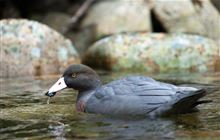Whio take flight in Canterbury
Archived content: This media release was accurate on the date of publication.
Introduction
Thirteen juvenile whio/blue duck are now riding river rapids in Arthur’s Pass National Park, after being helicoptered to their new home last week.Date: 31 January 2023
Eight of the threatened-nationally vulnerable ducks were set free on the Edwards River and the rest on the Poulter River, both of which are on the Canterbury side of the park.
Whio are river specialists and one of the few waterfowl worldwide that live year-round on fast-flowing rivers.
The ducks travelled to the park by helicopter from Christchurch where they were raised by the Isaac Conservation and Wildlife Trust.
DOC Biodiversity Ranger Antje Wahlberg said the eggs or newly-hatched chicks came to the Trust’s Peacock Springs breeding facility from three captive pairs held at Orana Wildlife Park and Willowbank Wildlife Reserve in Christchurch, as well as from Kiwi Park Queenstown.
“These pairs have been very successful in producing ducklings for later release into the wild. They have given us over 100 juveniles over the past five years,” Antje Wahlberg says.
“This success means we’ve been able to extend the whio recovery sites in Arthur’s Pass and release juveniles there as well as into the Central Southern Alps security site focused around the Styx-Arahura-Taipo valleys near Hokitika.”
This security site is one of eight around the country set up to ensure viable whio populations.
“DOC is really grateful to the Isaac Trust, as well as all our other partners around the country, which help with breeding assistance programmes,” Antje Wahlberg says.
Stoats are the greatest danger for whio as they nest in areas where stoats commonly feed. Female whio are frequently killed while on the nest.
DOC partners with Genesis in the Whio Forever Recovery Programme.
Genesis’ investment through the programme has included funding for over 5,000 traps protecting nearly 1700 km of river networks.
The number of whio pairs nationwide has increased from 298 to over 860 since the partnership began.
Further information
- Whio/blue duck are found nowhere else in the world and are rarer than some species of kiwi.
- Whio are a key indicator of healthy rivers and streams.
- Once widespread throughout New Zealand today they are limited to the less modified catchments of Te Urewera, East Cape and central areas of the North Island; and along the West Coast of the South Island from Nelson to Fiordland.
- Populations are patchy and isolated. They have low reproductive success, and there are more males than females.
Contact
For media enquiries contact:
Email: media@doc.govt.nz

